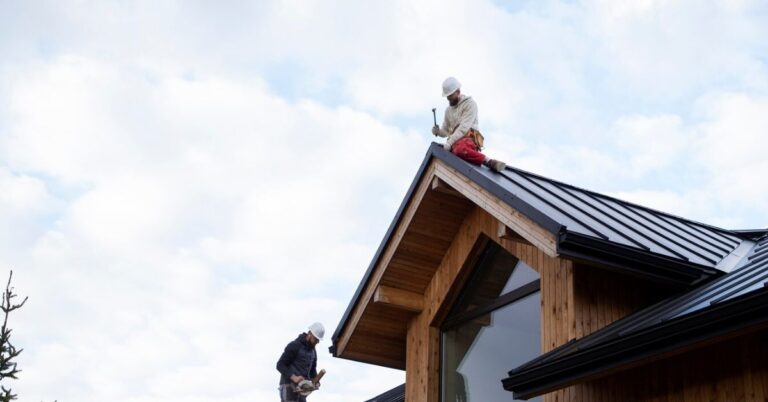A roof is one of the most essential elements of a home, protecting everything underneath it from the weather and outside elements. When the job is done well, you don’t have to think twice about it. But if the work is rushed, poorly managed, or completed without proper attention to detail, problems can arise quickly and are often expensive to fix. Hiring the wrong contractor can lead to roof leaks, structural damage, and safety concerns. We will explore the common signs of poor workmanship from inexperienced roofing contractors and how homeowners can catch them before things worsen.
Common signs of poor workmanship
- Misaligned Shingles and Visible Unevenness
One of the first visual cues that something went wrong during a roof replacement is the appearance of the shingles. Uneven shingles, staggered improperly or misaligned, can make a roof look sloppy from the street. But this isn’t just an aesthetic issue—it often signals deeper concerns about how carefully the contractor followed guidelines. Proper shingle alignment by a roof replacement contractor helps protect the underlying materials and maintain a watertight seal. If shingles are installed with gaps, overlaps in the wrong place, or patterns that deviate from the manufacturer’s instructions, water can seep underneath during heavy rain.
Over time, this can lead to mold growth, damaged insulation, or even rotting wood. Inexperienced contractors may rush the job, failing to snap chalk lines or check their work as they go. This shortcut may save them time, but it will almost certainly cost the homeowner later. Misaligned shingles can also cause wind damage to occur more quickly. If shingles aren’t set securely and in the correct pattern, high winds can catch their edges and tear them off.
Another telltale sign is an inconsistent ridge line—when the top of the roof looks wavy or doesn’t follow a straight path. This may suggest the decking underneath wasn’t installed evenly or that the contractor didn’t correctly address structural concerns before laying down shingles. It’s easy for an untrained eye to miss these early signs, but a close look at the roofline and shingle pattern can often tell you if the contractor knew what they were doing.
- Improper Flashing Installation and Water Intrusion Risks
Flashing is one of the most crucial components in any roofing system. It’s the thin metal material that seals roof joints, valleys, and areas around chimneys, vents, and skylights. When flashing is poorly installed—or skipped altogether—it leaves vulnerable spots where water can quickly enter the structure. Unfortunately, flashing errors are common when inexperienced contractors take on roofing jobs. Some may reuse old flashing instead of replacing it, which can compromise the seal around critical areas. Others might apply it haphazardly or seal it with the wrong adhesive or caulk.
This leads to a roof that appears intact at first glance but quickly develops leaks, especially during storms or snow melts. One of the easiest ways to check for flashing problems is to inspect roof features like chimneys or vent pipes. Gaps, loose metal, or a lack of sealant can all point to shortcuts taken during the job. Poor flashing also contributes to ice dam formation in colder regions, where water gets trapped and seeps under the shingles.
A properly trained contractor will know how to install flashing in a way that complements the roofing materials and aligns with industry standards. When these standards are ignored, leaks aren’t a question of if—they’re a question of when. Left unresolved, they can travel deep into the attic, damage ceilings and walls, and create significant repair costs. For homeowners, noticing water stains indoors, musty smells, or even visible light coming through the roof near flashing points are all clues that something wasn’t done right the first time.
- Neglected Ventilation and Moisture Build-Up
Less experienced roofing contractors often overlook proper ventilation, yet it plays a huge role in the health of the roof and the home’s overall energy efficiency. Roof ventilation allows hot air and moisture to escape from the attic space, preventing heat buildup in summer and condensation in winter. If a contractor fails to install proper ventilation or blocks existing vents, it can lead to premature aging of shingles, mold growth in the attic, and even warped decking. Poor ventilation can also increase energy bills, as your HVAC system works harder to cool an overheated home.
A common sign of ventilation issues caused by poor roofing work is the appearance of mold or mildew in the attic, especially around roof trusses or insulation. You may also notice your upper floor feels significantly warmer or more humid than the rest of the house. These signs often don’t appear until weeks or months after the work is done, so homeowners are encouraged to have their attic inspected after a roof replacement.
In some cases, the contractor may have installed ridge vents without ensuring that soffit vents are open and unblocked, creating an imbalance that does nothing to improve airflow. Without a continuous cycle of intake and exhaust, heat and moisture are trapped inside the attic space. This kind of oversight shows a lack of planning and understanding of how all parts of a roofing system work together. Long-term, poor ventilation can reduce the life expectancy of your entire roof. Homeowners who suspect ventilation problems should have a trusted inspector evaluate the attic space, especially if they’ve recently had work done by a contractor they were unsure about.
The signs of poor roofing workmanship may not always show up immediately, but they will eventually become known through leaks, warping, or even premature roof failure. Spotting these warning signs early can prevent further damage and save significant repair costs. These issues often reflect inexperience and poor training, from uneven shingles to faulty flashing and ignored ventilation. After installing a new roof, homeowners should look beyond surface appearances and stay attentive to subtle signs. Inspecting the details can ensure the roof does more than just look good—it performs as it should for years.

